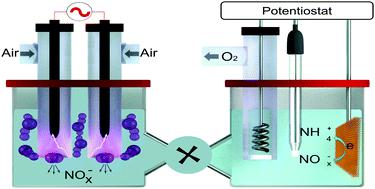当前位置:
X-MOL 学术
›
Energy Environ. Sci.
›
论文详情
Our official English website, www.x-mol.net, welcomes your
feedback! (Note: you will need to create a separate account there.)
A hybrid plasma electrocatalytic process for sustainable ammonia production
Energy & Environmental Science ( IF 32.4 ) Pub Date : 2021-1-19 , DOI: 10.1039/d0ee03769a Jing Sun 1, 2, 3 , David Alam 2, 3, 4 , Rahman Daiyan 1, 2, 3 , Hassan Masood 1, 2, 3 , Tianqi Zhang 2, 3, 4 , Renwu Zhou 2, 3, 4 , Patrick J. Cullen 2, 3, 4 , Emma C. Lovell 1, 2, 3 , Ali (Rouhollah) Jalili 1, 2, 3 , Rose Amal 1, 2, 3
Energy & Environmental Science ( IF 32.4 ) Pub Date : 2021-1-19 , DOI: 10.1039/d0ee03769a Jing Sun 1, 2, 3 , David Alam 2, 3, 4 , Rahman Daiyan 1, 2, 3 , Hassan Masood 1, 2, 3 , Tianqi Zhang 2, 3, 4 , Renwu Zhou 2, 3, 4 , Patrick J. Cullen 2, 3, 4 , Emma C. Lovell 1, 2, 3 , Ali (Rouhollah) Jalili 1, 2, 3 , Rose Amal 1, 2, 3
Affiliation

|
From nurturing living organisms to feeding billions of people, the transformation of atmospheric nitrogen to ammonia (NH3) is essential to sustain life on earth. In nature, bacteria and plants can produce ammonia from air and water at ambient conditions via nitrogen fixation processes. To follow this feat, we couple plasma-driven nitrogen oxides intermediary (NOx) generation and their electrocatalytic reduction to pave the way for scalable green ammonia at ambient conditions. We developed a non-thermal plasma bubble column reactor that brings together dual reactor configuration with multiple discharge schemes and bubble dynamic control to generate NOx intermediaries at low specific energy consumption of 3.8 kW h mol−1. The NOx intermediaries were converted to ammonia at a rate of 23.2 mg h−1 (42.1 nmol cm−2 s−1), using a scalable electrolyzer operating at a low cell voltage of 1.4 V, current densities of over 50 mA cm−2, and specific energy consumption of 0.51 kW h mol−1 NH3.
中文翻译:

可持续生产氨的混合等离子体电催化工艺
从培育生物体到养活数十亿人,大气中的氮到氨(NH 3)的转化对于维持地球上的生命至关重要。在自然界中,细菌和植物可以通过固氮工艺在环境条件下从空气和水中产生氨。为了遵循这一壮举,我们将等离子驱动的氮氧化物中间体(NO x)的产生及其电催化还原结合在一起,为在环境条件下可扩展的绿色氨水铺平了道路。我们开发了汇集的双反应器配置有多个放电方案和气泡的动态控制,以产生一个NO非热等离子体鼓泡塔反应器X在3.8千瓦ħmol的低比能耗中介-1。使NO X中介物在23.2毫克h的速率转化成氨-1(42.1纳摩尔厘米-2小号-1),使用可缩放电解器操作在1.4 V的低电池电压,过50毫安厘米的电流密度-如图2所示,比能量消耗为0.51kWhmol -1 NH 3。
更新日期:2021-01-26
中文翻译:

可持续生产氨的混合等离子体电催化工艺
从培育生物体到养活数十亿人,大气中的氮到氨(NH 3)的转化对于维持地球上的生命至关重要。在自然界中,细菌和植物可以通过固氮工艺在环境条件下从空气和水中产生氨。为了遵循这一壮举,我们将等离子驱动的氮氧化物中间体(NO x)的产生及其电催化还原结合在一起,为在环境条件下可扩展的绿色氨水铺平了道路。我们开发了汇集的双反应器配置有多个放电方案和气泡的动态控制,以产生一个NO非热等离子体鼓泡塔反应器X在3.8千瓦ħmol的低比能耗中介-1。使NO X中介物在23.2毫克h的速率转化成氨-1(42.1纳摩尔厘米-2小号-1),使用可缩放电解器操作在1.4 V的低电池电压,过50毫安厘米的电流密度-如图2所示,比能量消耗为0.51kWhmol -1 NH 3。









































 京公网安备 11010802027423号
京公网安备 11010802027423号